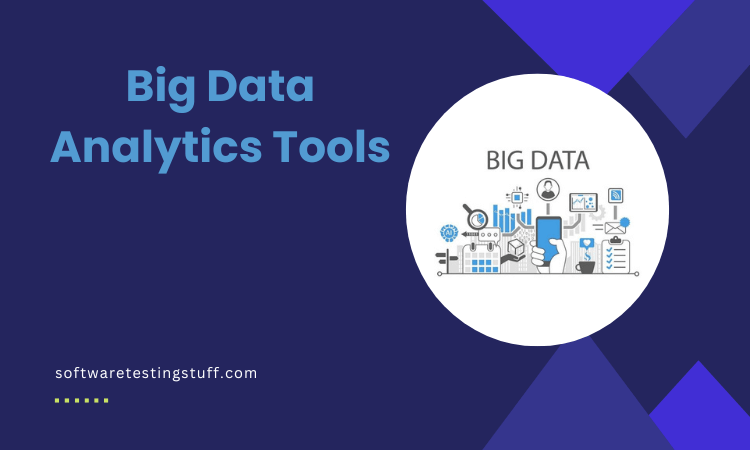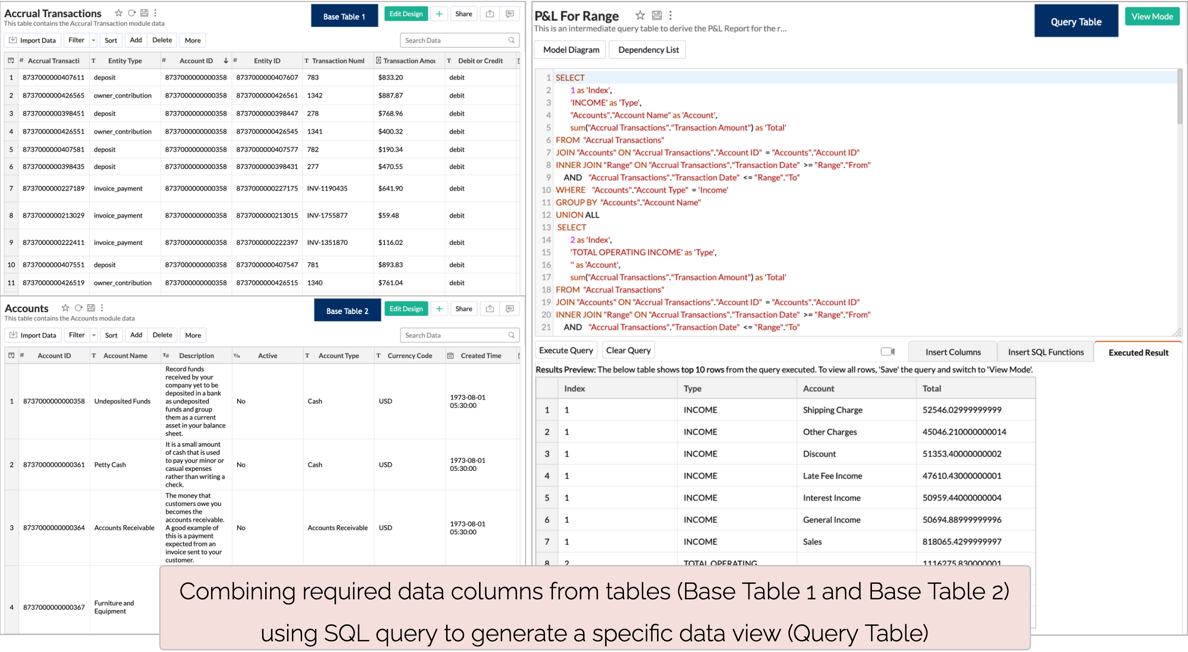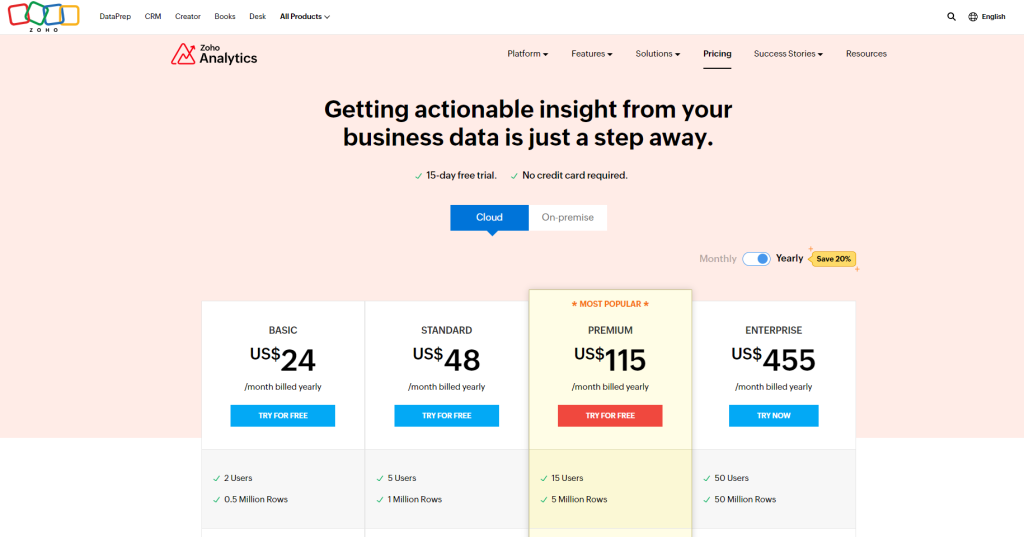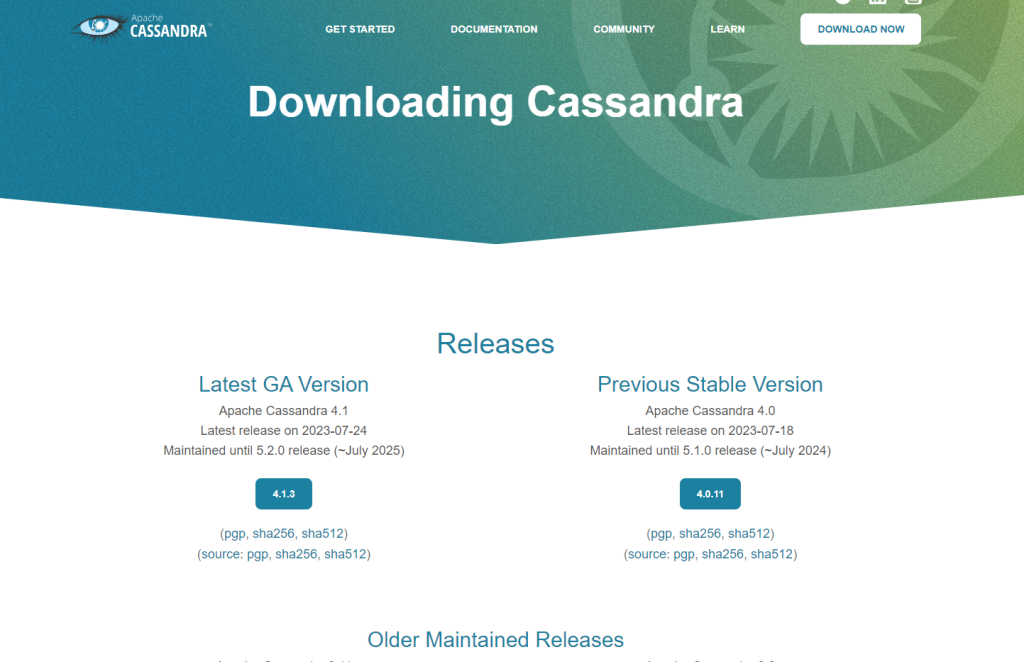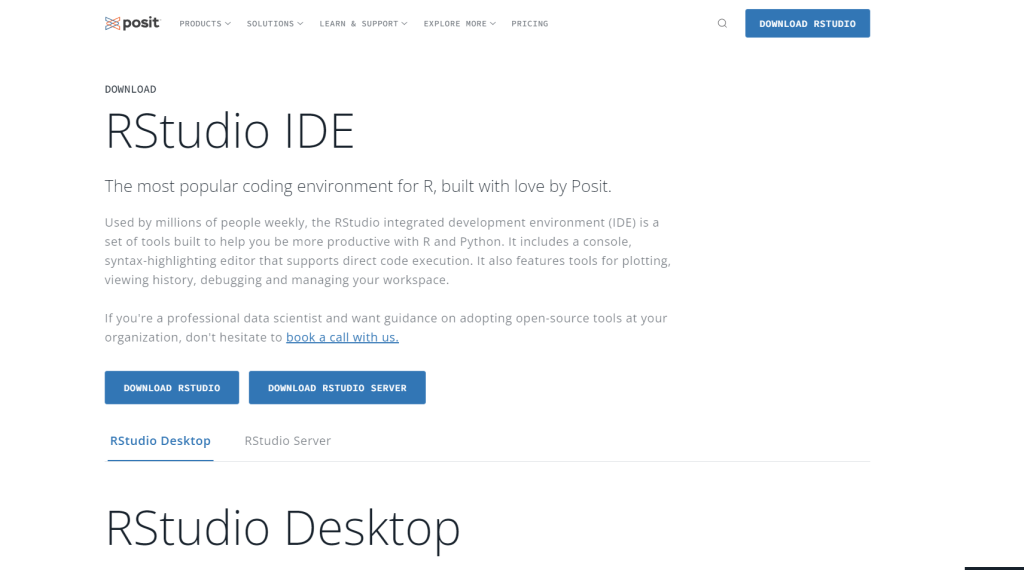In the vast expanse of today’s digital landscape, the sheer volume of data generated is staggering. Every online transaction, social media interaction, and user engagement contributes to this monumental data flow.
Among this deluge of data, a revolution has sprung, and at its core are powerful big data analytics tools. These tools have become the guiding beacons for organizations seeking to unravel the secrets hidden within the labyrinth of data.
In essence, these tools are the modern-day torchbearers, illuminating the path from raw data to meaningful information. They help businesses uncover opportunities, refine strategies, and make informed decisions by analyzing colossal datasets.
Quick List of 5 Big Data Analytics Tools
Explore this selection of the best big data analytics tools, each uniquely suited to tackle the challenges of modern data management and analysis.
1. Zoho Analytics: It stands out for its intuitive interface, making data analysis accessible to everyone in your organization.
2. Cassandra: It excels in handling massive data loads while maintaining high availability and fault tolerance.
3. R-Programming: R-Programming provides a powerful platform for sophisticated data analysis and predictive modeling.
4. Microsoft Power BI: It’s automation empowers you to harness the potential of machine learning for accurate predictions.
5. MongoDB: MongoDB’s adaptable document-oriented approach ensures seamless data management, catering to various data types and needs.
Comparison Table of Big Data Analytics Tools
Here’s a concise comparison table highlighting key aspects of popular big data analytics tools, helping you make an informed choice based on critical criteria.
Tool | Support | Ability to Integrate | Processing Power |
 | Robust customer support | Seamless integration | Efficient data processing |
 | Active community and resources | Integration versatility | Distributed data processing |
 | Rich user community and documentation | Diverse integration | Advanced statistical analysis |
 | Strong technical support | Tool integration | Automated machine learning |
 | Comprehensive documentation | Integrates effectively | Flexible data processing |
What are Big Data Analytics Tools?
Big data analytics tools are software applications designed to extract valuable insights and patterns from vast and complex data sets. Companies today collect massive amounts of data from various sources, including customer interactions, transactions, social media, and more.
Big data tools and technologies serve as essential instruments in processing, analyzing, and deriving meaningful insights from this data.
These tools encompass a range of functionalities that enable businesses to:
Data Processing
Analytics tools for big data handle the processing of large and diverse data sets, ensuring that data is cleansed, transformed, and prepared for analysis.
Data Analysis
They employ advanced algorithms and statistical techniques to uncover trends, correlations, and patterns within the data, revealing insights that can guide decision-making.
Data Visualization
These tools facilitate the creation of visual representations like graphs, charts, and dashboards, making complex data more understandable and actionable.
Predictive Modeling
Analytics tools for big data enable the creation of predictive models based on historical data, helping organizations anticipate future trends and outcomes.
Machine Learning
Many of these tools integrate machine learning capabilities, allowing systems to learn from data and make accurate predictions or decisions.
Real-time Analysis
Some tools offer real-time analytics, allowing organizations to gain insights and respond to changing conditions in a dynamic environment.
Scalability
Tools for big data analytics are designed to handle large volumes of data, ensuring that organizations can effectively analyze information as it grows.
Business Intelligence
They provide business intelligence by offering actionable insights that inform strategic planning, marketing campaigns, product development, and more.
How Big Data Analytics Tools Can Help Your Software Development or Testing
Software development and testing have benefited greatly from big data tools and technologies that enhance efficiency, quality, and overall project success. By using data, these tools can optimize various aspects of the development and testing lifecycle, ultimately resulting in more reliable software.
Here’s how big data analytics tools can make a significant impact:
Data-Driven Insights
These tools allow software development teams to analyze vast amounts of data generated during the development lifecycle. By extracting insights from this data, developers can identify trends, patterns, and potential bottlenecks.
This information guides decision-making, enabling teams to make proactive adjustments and optimizations.
Quality Assurance
Testing is a critical phase in software development, and analytics tools for big data play a pivotal role in ensuring quality. These tools analyze test data, user behavior, and feedback to identify areas of improvement.
Testing teams can enhance test coverage when anomalies and patterns are detected.
Bug Detection and Prediction
Big data analytics tools can assist in detecting and predicting bugs by analyzing historical data and identifying common issues. It prevents critical bugs from affecting the final product by addressing potential problems early.
Performance Optimization
Software performance is essential for user satisfaction. Big data analytics tools can analyze performance metrics and user behavior to identify performance bottlenecks and areas for optimization.
It ensures that the software delivers a smooth and responsive user experience.
User Experience Enhancement
Understanding user behavior and preferences is vital. They analyze user interactions and feedback, enabling developers to tailor software features to user needs and preferences.
Predictive Analytics
By utilizing historical data and predictive modeling, these tools can forecast trends, user demands, and potential challenges. This information guides development strategies and ensures the software remains relevant and competitive.
Agile Decision-Making
For agile development methodologies, they provide real-time insights into project progress, resource allocation, and potential risks. Agile testing teams can then make informed decisions to adapt and optimize their processes.
Continuous Improvement
They facilitate continuous improvement by providing data-driven feedback on development and testing practices. This iterative approach allows teams to refine their processes over time.
Why Big Data Analytics Tools Are Important to Your Software Testing?
As software testing becomes increasingly complex and data-rich, these tools are becoming increasingly important. A transformative approach to software testing, these tools ensure thorough testing, efficient analysis, and improved quality assurance.
Here’s why integrating big data analytics tools into your software testing strategy is paramount:
Comprehensive Test Coverage
As applications grow in size and complexity, traditional testing methods may fall short in covering all possible scenarios. Using big data analytics, test cases can be created from vast datasets and potential edge cases can be identified.
Efficient Bug Detection
Identifying bugs and defects manually can be time-consuming and error-prone. They accelerate bug detection by analyzing diverse data points, helping testers identify patterns and anomalies that might indicate underlying issues.
Predictive Analysis
Leveraging historical testing data, these tools can predict potential issues, enabling proactive measures to prevent defects before they arise. This predictive analysis enhances the overall quality of the software and reduces last-minute debugging efforts.
Performance Optimization
Monitoring application performance is crucial for user satisfaction. Analyzing big data helps testers identify performance bottlenecks and optimize performance across conditions and user interactions.
Real-time Monitoring
With the increasing emphasis on continuous integration and continuous delivery (CI/CD), real-time monitoring becomes essential. These tools provide real-time insights into application behavior, enabling testers to detect issues as they occur and react swiftly.
User-Centric Testing
Understanding user behavior and preferences is essential for effective testing. Analyzing big data allows testers to simulate real-life scenarios for the application and ensure it meets users’ expectations.
Test Data Generation
Generating diverse and realistic test data can be challenging. The best big data analytics tools can generate test data sets that encompass a wide range of scenarios, ensuring thorough testing of various functionalities.
Data-Driven Decision Making
Testing decisions based on data-driven insights leads to more informed choices. Analytics tools offer actionable insights that guide testing strategies, resource allocation, and risk assessment.
Continuous Improvement
By analyzing testing data over time, these tools facilitate continuous improvement of testing processes. Teams can refine their strategies based on historical performance metrics and user feedback.
Best Big Data Analytics Tools
Let’s learn about them more comprehensively —
1. Zoho Analytics

Zoho Analytics, a leading big data analytics tool, empowers businesses to harness the full potential of their data. Designed for both novices and experts, this platform enables you to transform raw data into actionable insights.
From sales trends to customer behavior, Zoho Analytics equips you with the tools needed to make informed decisions that drive growth and efficiency.
About Zoho Analytics:
- Number of Employees: Approximately 8,000+
- Founding Team: Sridhar Vembu
Key Features:
1. Multi-Platform Accessibility
Access your data and insights on-the-go through the Zoho Analytics mobile app or the web-based platform. This flexibility allows you to stay connected and make data-driven decisions from anywhere.
2. Seamless Integrations
Zoho Analytics offers integrations with popular tools like Zoho CRM, Google Analytics, and more. This integration capability streamlines data collection and analysis, providing a holistic view of your operations.
3. User-Friendly Interface (UX)
The intuitive interface simplifies the process of data visualization and analysis. Drag-and-drop features, customizable dashboards, and a wide array of chart options make complex data understandable at a glance.
4. Data Blending
Combine data from various sources to uncover hidden correlations and insights. Zoho Analytics enables you to create a comprehensive view of your data landscape.
5. Advanced Analytics
From predictive analytics to what-if scenarios, Zoho Analytics offers a range of advanced analytical tools. Dive deeper into your data and uncover patterns that can drive strategic decision-making.
Pros of using Zoho Analytics:
- Intuitive interface for easy adoption
- Cross-platform accessibility enhances flexibility
- Robust integration options for comprehensive insights
- Advanced analytics capabilities for sophisticated analyses
- Data blending feature enables a holistic view
Cons of using Zoho Analytics:
- Some advanced features may require a learning curve
- Customization options might be overwhelming for beginners
- Limited free version functionality in comparison to premium plans
Pricing
- Basic Plan: $24 per month for 2 users
- Standard Plan: $48 per month for 5 users
- Premium Plan: $115 per month for 155 users
Enterprise Plan: $455 per month for 50 users
Customer Ratings:
- G2: 4.2 Based on 284 reviews
Our Review of Zoho Analytics:
Zoho Analytics stands out as a comprehensive and accessible data analytics tool. Its multi-platform availability, smooth integrations, and user-friendly interface make it an appealing choice for businesses seeking to unlock valuable insights from their data.
The ability to blend data from diverse sources and delve into advanced analytics sets it apart in the market. While there might be a slight learning curve for certain advanced features, the overall value Zoho Analytics offers for decision-making overshadows any initial challenges.
Whether you’re a startup or an established enterprise, Zoho Analytics presents a compelling solution to elevate your data analysis game.
2. Cassandra

Cassandra, a powerful NoSQL database management system, is the go-to choice for organizations dealing with massive amounts of data. Its distributed architecture and fault-tolerant design address the challenges of today’s data-intensive applications.
From real-time analytics to managing high-velocity data streams, Cassandra delivers unparalleled performance, availability, and scalability. Modern data management strategies use Cassandra to handle large amounts of data without compromising speed.
About Product:
- Number of Employees: N/A (Open Source Project with Community Contributors)
- Founding Team: Facebook (Developed at Facebook)
Key Features:
1. Distributed Architecture
Cassandra’s decentralized architecture distributes data across multiple nodes, ensuring data redundancy and high availability. This design minimizes the risk of data loss and downtime, crucial for applications with strict reliability requirements.

2. Linear Scalability
Cassandra’s ability to scale horizontally allows organizations to add more hardware as data grows, maintaining performance levels without costly hardware upgrades. This scalability is essential for applications experiencing rapid data growth.
3. No Single Point of Failure
With its fault-tolerant design, Cassandra eliminates single points of failure. Data is replicated across nodes, ensuring data integrity and availability even in the face of hardware failures.

4. Flexible Data Model
Cassandra’s schema-free data model allows for dynamic, changing data structures. This flexibility is particularly useful for applications with evolving data requirements.
5. Tunable Consistency
Cassandra offers tunable consistency levels, allowing organizations to balance data consistency and availability based on their application’s needs.
Pros of using Cassandra:
- Exceptional scalability for large and growing datasets
- High availability and fault tolerance
- Schema flexibility for dynamic data models
- Support for real-time data processing and analytics
- Open-source nature lowers entry barriers
Cons of using Cassandra:
- Complexity in setting up and managing distributed databases
- Learning curve for users accustomed to relational databases
- Limited support for complex queries compared to some other databases
Pricing
- It’s a free NoSQL Database and Open-Source
Customer Ratings:
- G2: 4.1 based on 34 reviews
Our Review of Cassandra:
Cassandra emerges as a big data analytics tools open source solution for enterprises. Its distributed architecture, scalability, and fault tolerance position it as a reliable choice for mission-critical applications.
While the learning curve might be steeper for those accustomed to relational databases, performance, availability, and data integrity make it worthwhile. Despite Cassandra’s open-source nature, it’s important to take into account the investment required for proficient deployment.
If your organization seeks to harness the power of large-scale data with a focus on scalability and availability, Cassandra stands as a formidable contender in the database landscape.
3. R-Programming

In various industries, R has become the cornerstone of data analysis and statistical modeling. It’s one of the best big data analytics tools open source. With its robust libraries and extensive capabilities, it empowers users to manipulate, visualize, and draw insights from data.
From data scientists to business analysts, R offers an array of benefits, making it an essential tool for decision-making and predictive modeling. With R, you can explore trends, build predictive models, or create data visualizations to uncover meaningful insights.
About Product:
- Number of Employees: N/A (Open Source Project with Community Contributors)
- Founding Team: Ross Ihaka, Robert Gentleman
Key Features:
1. Versatile IDE – RStudio
RStudio provides an intuitive interface for writing, testing, and executing R code. It includes features like code auto-completion, error checking, and interactive data visualization, enhancing the user experience.
2. Extensive Package Library (CRAN)
R boasts a vast repository of packages that cater to different analytical needs. Whether it’s data cleaning, machine learning, or time series analysis, the packages in CRAN empower users with specialized tools.
3. Data Visualization
R’s visualization libraries, such as ggplot2, offer the ability to create complex and insightful data visualizations. These visualizations are crucial for conveying findings and trends effectively.
4. Statistical Modeling
R’s strength lies in its statistical modeling capabilities. Users can build complex models for predictive analysis, regression, clustering, and more.

5. Data Manipulation
R’s dplyr package simplifies data manipulation tasks, enabling users to clean, transform, and reshape data efficiently.
Pros of using R-Programming:
- Open-source nature eliminates licensing costs
- Strong statistical modeling and data analysis capabilities
- Vast package library for diverse analytical needs
- Interactive data visualization enhances insights
- Active community support and frequent updates
Cons of using R-Programming:
- Steeper learning curve for beginners without programming experience
- Memory limitations for handling extremely large datasets
- Some packages might lack extensive documentation
Pricing
- R-Programming and RStudio are both open-source and available for free.
Customer Ratings:
- G2: 4.5 based on 550 reviews
Our Review of R-Programming:
R-Programming stands as a powerhouse tool for individuals and professionals seeking to harness the power of data through statistical analysis and modeling. Packages, an IDE in RStudio, and features in data visualization and manipulation make it a go-to choice for data-driven decisions.
While newcomers might face a learning curve, the abundant resources and active community support mitigate this challenge. The open-source nature aligns well with budget-conscious organizations and individuals. A key strength of R-Programming is its ability to accommodate a wide range of analytics needs, from data scientists to business analysts.
4. Microsoft Power BI

Microsoft Power BI stands as a formidable tool in the realm of data analytics and visualization. It’s the go-to solution for individuals and businesses seeking to turn raw data into insightful visuals and interactive reports.
With its user-friendly interface and robust capabilities, Power BI has transformed data analysis into an intuitive and efficient process. In addition to tracking key performance indicators, Power BI can be used to explore complex datasets and make informed decisions.
About Product:
- Number of Employees: Microsoft Corporation (tens of thousands worldwide)
- Founding Team: Developed by Microsoft as part of the Power Platform suite
Key Features:

1. Multi-Platform Availability
It’s accessible as a desktop application, a web-based service, and mobile apps for iOS and Android devices. This ensures data accessibility anytime, anywhere.
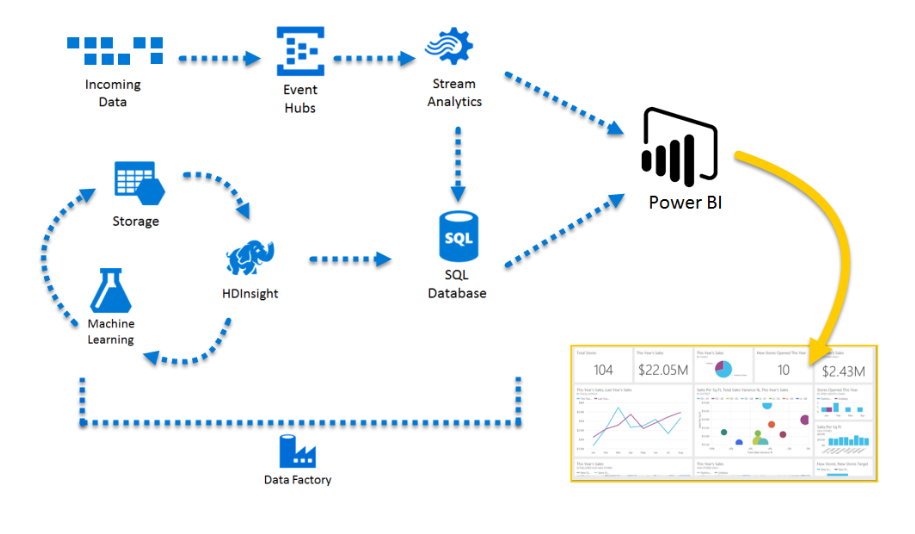
2. Seamless Integrations
The tool integrates seamlessly with other Microsoft products such as Excel, SharePoint, and Azure. It also connects with a wide range of data sources, from cloud services to databases.
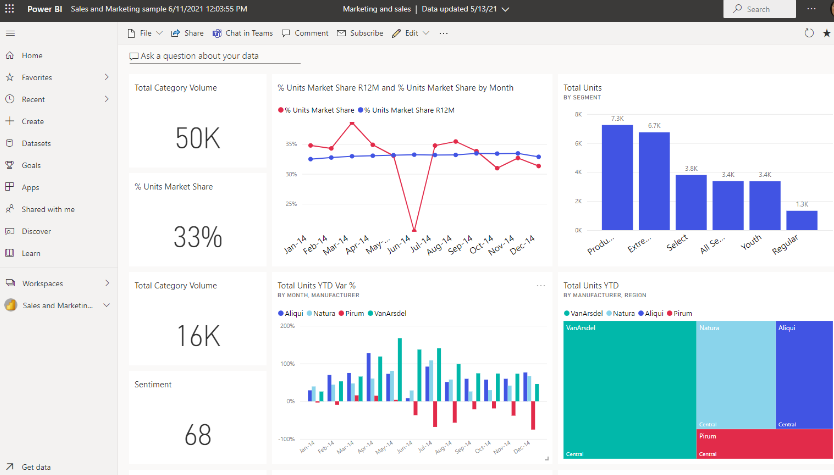
3. Interactive Data Visualizations
Power BI enables users to create interactive reports and dashboards with a drag-and-drop interface. These visuals allow for deeper exploration and better understanding of data insights.
4. Natural Language Queries
Users can employ natural language queries to explore data and receive instant responses. This feature simplifies data exploration for users without technical backgrounds.
5. AI-Powered Insights
Power BI employs artificial intelligence to automatically detect patterns, trends, and anomalies in data, providing valuable insights without the need for manual analysis.
6. Collaboration and Sharing
The tool facilitates collaborative efforts by allowing users to share reports, dashboards, and datasets with colleagues securely. Real-time collaboration ensures everyone is on the same page.
Pros of Using Microsoft Power BI:
- User-friendly interface for easy data visualization
- Extensive integration capabilities within the Microsoft ecosystem
- Interactive and customizable reports and dashboards
- Natural language queries for simplified data exploration
- AI-driven insights enhance data analysis efficiency
- Seamless collaboration and sharing features
Cons of Using Microsoft Power BI:
- Learning curve for advanced functionalities
- Limited offline capabilities in the web-based version
- Complex data transformations may require technical expertise
Pricing
- Power BI Pro: $10 per user
- Power BI Premium: $20 to $4,995 based on your usage
Customer Ratings:
- G2: 4.4 based on 1,000 reviews
Our Review of Microsoft Power BI:
Microsoft Power BI is undoubtedly a leader in the field of data analytics and visualization. Its multi-platform availability, seamless integrations, and interactive visuals make it a top choice for individuals and businesses alike.
Mastering its advanced features may require a learning curve, but the benefits in terms of data analysis, AI, and collaboration outweigh any challenges. Power BI serves as a game-changer for those seeking to derive actionable insights from data and drive strategic decision-making processes.
5. MongoDB

MongoDB, a popular NoSQL database, has revolutionized data management with its flexible and scalable architecture. It manages and analyzes unstructured and semi-structured data, making it a perfect choice for businesses.
With its document-oriented approach, MongoDB enables users to store, retrieve, and manipulate data efficiently. In addition to traditional relational databases, it is suitable for e-commerce, content management, and real-time analytics.
About Product:
- Number of Employees: Approximately 5,000+
- Founding Team: Dwight Merriman, Eliot Horowitz, Kevin Ryan
Key Features:
1. Flexible Document Model
MongoDB’s document-oriented data model allows users to store data in a format that mirrors real-world structures. This flexibility is ideal for applications with evolving data requirements.

2. Horizontal Scalability
It’s ability to scale horizontally by adding more servers helps maintain performance as data grows. This is crucial for applications with high data velocity.
3. Indexing and Querying
The platform supports various indexing techniques, enabling efficient data retrieval. Its query language allows users to perform complex searches on data.
4. Replication and High Availability
It offers automatic data replication across multiple servers, ensuring high availability and data redundancy.
5. Atlas Cloud Hosting
MongoDB Atlas simplifies deployment by handling administrative tasks like scaling and backups. It ensures security with built-in authentication and encryption features.
Pros of using MongoDB:
- Flexible data model accommodates diverse data types
- Horizontal scalability supports growing data needs
- Rich query language for powerful data retrieval
- Replication and high availability enhance data reliability
- MongoDB Atlas streamlines cloud-based deployment
Cons of using MongoDB:
- Complex queries might require learning more about the query language
- Large-scale data migrations can be challenging
- Advanced features might lead to performance optimization challenges
Pricing
- Serverless: $0.10 for 1TB storage
- Dedicated: $57 10GB to 4TB storage
- Shared: $0 512MB to 5GB storage
Customer Ratings:
- G2: 4.5 based on 498 reviews
Our Review of MongoDB:
MongoDB stands as a robust solution for organizations seeking a versatile and scalable database system. Its flexible data model and horizontal scalability address modern data challenges effectively.
While its query language might require a learning curve, MongoDB’s rich indexing and querying capabilities provide ample tools for data retrieval. The availability of MongoDB Atlas simplifies cloud-based deployment, making it an attractive option for businesses embracing cloud infrastructure.
Large-scale data migrations may present challenges, however, the benefits of scalability and flexibility far outweigh these. Its active development and community support make it a strong contender in the NoSQL database landscape. No matter how big or small your company is, MongoDB offers you a valuable solution.
Frequently Asked Questions – FAQs
1. What benefits do these tools bring to software development?
They offer data-driven insights, bug prediction, performance optimization, and user-centric testing, ultimately leading to more reliable and user-friendly software.
2. Can analytics tools for big data predict trends and behavior?
Yes, these tools use historical data and predictive modeling to forecast trends, user behavior, and potential challenges.
3. How do analytics tools for big data contribute to decision-making?
These tools provide actionable insights that guide testing strategies, development decisions, and resource allocation, fostering data-driven decision-making.
Conclusion
In an era where information is power, big data analytics tools stand as the ultimate enablers of transformation. They bridge the gap between raw data and actionable insights, transforming businesses and industries alike. Data analytics tools have revolutionized the way we approach data from software testing to market trends.
As we bid adieu to this exploration of the capabilities of analytics tools for big data, it becomes evident that their impact is both profound and far-reaching. Technology and data convergence is enabling businesses to unlock the doors to success by using these tools.
Using these tools, organizations can navigate the complex data landscape with confidence, making strategic decisions that propel them forward.
- 5 Best DevOps Platform and Their Detailed Guide For 2024 - December 26, 2025
- Top 10 Cross Browser Testing Tools: The Best Choices for 2024 - October 28, 2025
- 5 Best API Testing Tools: Your Ultimate Guide for 2024 - October 26, 2025
